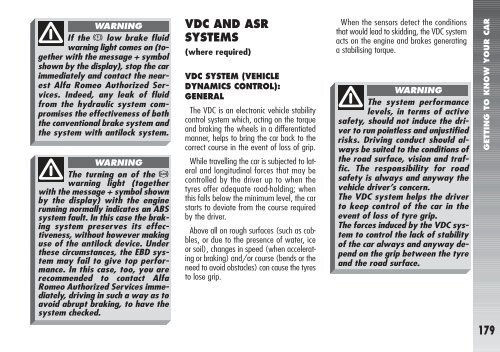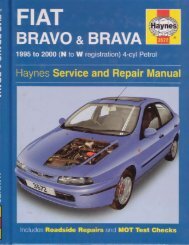001-055 Alfa 156 GB - Alfa Romeo serviss
001-055 Alfa 156 GB - Alfa Romeo serviss
001-055 Alfa 156 GB - Alfa Romeo serviss
You also want an ePaper? Increase the reach of your titles
YUMPU automatically turns print PDFs into web optimized ePapers that Google loves.
WARNING<br />
If the x low brake fluid<br />
warning light comes on (together<br />
with the message + symbol<br />
shown by the display), stop the car<br />
immediately and contact the nearest<br />
<strong>Alfa</strong> <strong>Romeo</strong> Authorized Services.<br />
Indeed, any leak of fluid<br />
from the hydraulic system compromises<br />
the effectiveness of both<br />
the conventional brake system and<br />
the system with antilock system.<br />
WARNING<br />
The turning on of the ><br />
warning light (together<br />
with the message + symbol shown<br />
by the display) with the engine<br />
running normally indicates an ABS<br />
system fault. In this case the braking<br />
system preserves its effectiveness,<br />
without however making<br />
use of the antilock device. Under<br />
these circumstances, the EBD system<br />
may fail to give top performance.<br />
In this case, too, you are<br />
recommended to contact <strong>Alfa</strong><br />
<strong>Romeo</strong> Authorized Services immediately,<br />
driving in such a way as to<br />
avoid abrupt braking, to have the<br />
system checked.<br />
VDC AND ASR<br />
SYSTEMS<br />
(where required)<br />
VDC SYSTEM (VEHICLE<br />
DYNAMICS CONTROL):<br />
GENERAL<br />
The VDC is an electronic vehicle stability<br />
control system which, acting on the torque<br />
and braking the wheels in a differentiated<br />
manner, helps to bring the car back to the<br />
correct course in the event of loss of grip.<br />
While travelling the car is subjected to lateral<br />
and longitudinal forces that may be<br />
controlled by the driver up to when the<br />
tyres offer adequate road-holding; when<br />
this falls below the minimum level, the car<br />
starts to deviate from the course required<br />
by the driver.<br />
Above all on rough surfaces (such as cobbles,<br />
or due to the presence of water, ice<br />
or soil), changes in speed (when accelerating<br />
or braking) and/or course (bends or the<br />
need to avoid obstacles) can cause the tyres<br />
to lose grip.<br />
When the sensors detect the conditions<br />
that would lead to skidding, the VDC system<br />
acts on the engine and brakes generating<br />
a stabilising torque.<br />
WARNING<br />
The system performance<br />
levels, in terms of active<br />
safety, should not induce the driver<br />
to run pointless and unjustified<br />
risks. Driving conduct should always<br />
be suited to the conditions of<br />
the road surface, vision and traffic.<br />
The responsibility for road<br />
safety is always and anyway the<br />
vehicle driver’s concern.<br />
The VDC system helps the driver<br />
to keep control of the car in the<br />
event of loss of tyre grip.<br />
The forces induced by the VDC system<br />
to control the lack of stability<br />
of the car always and anyway depend<br />
on the grip between the tyre<br />
and the road surface.<br />
GETTING TO KNOW YOUR CAR<br />
179

















